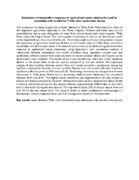| dc.description.abstract | The continuous increase of agricultural water demand in Thiba River Watershed as a result of the expansion agriculture especially in the Mwea Irrigation Scheme and other parts of the watershed has led to over abstraction of water from the scheme’s main water supplier, Thiba River, hence declining its flows. This river supplies a hydroelectric dam on its downstream and it is also depended upon by various livelihoods. This study sought to find out the potential impacts the expansion of agricultural lands would have on the stream flow of Thiba River and how it would affect the downstream users. The research was carried out by determining the streamflow response to agricultural water abstraction using Spearman’s rank correlation method. A relationship between streamflow and rainfall variability using regression analysis was also established. Different stream flow scenarios were simulated and their effects and impacts on the downstream users assessed. The results of the study showed that there was a very significant decline in the stream flow in the dry months compared to the wet months. The regression analysis of the variability between stream flow and rainfall provided a moderately strong but significant relationship between the two variables. Results from the model calibration showed a satisfactory efficiency with an NSE value of 0.50. The findings showed an increasing trend of water abstraction in Thiba basin. There was an increasing trend of water abstraction for the period between 2007 and 2014. The highest water abstraction was experienced in the dry months of January to February and June to October. Water abstraction analysis revealed that about 20,000 m3/day) is abstracted during the dry seasons whereas approximately 5000m3/day of the river’s flow is abstracted during the wet seasons. This represents about 35% of the dry season flow and only 3% of the wet season flow. This study is useful to water professionals and managers in developing a robust integrated water and land management system in the watershed.
Key words: water demand, Thiba river watershed, water abstraction, dry months, wet months
| en_US |

